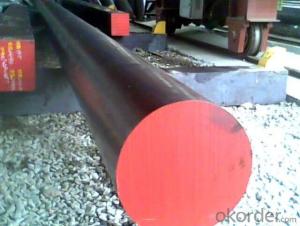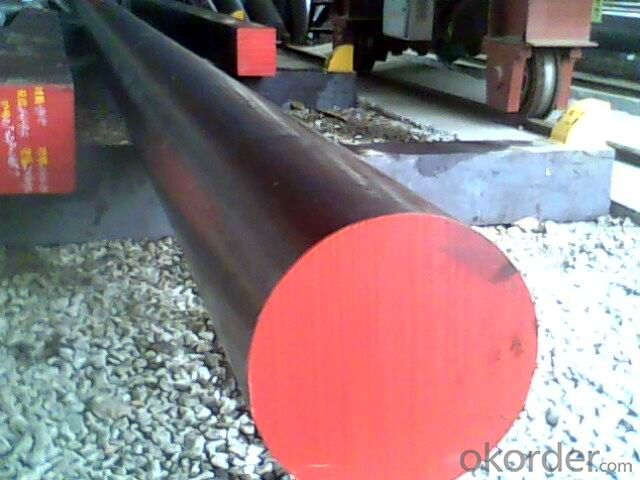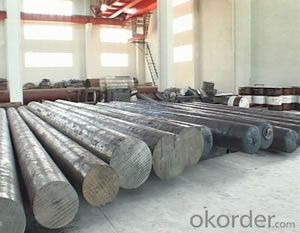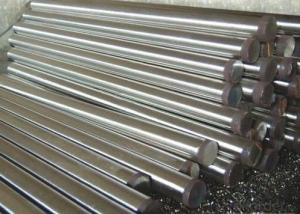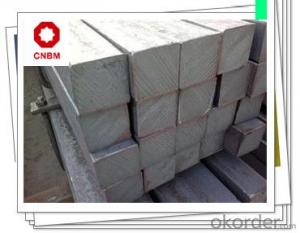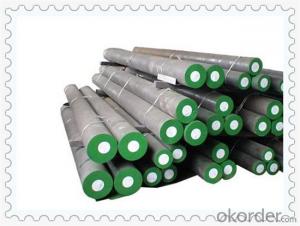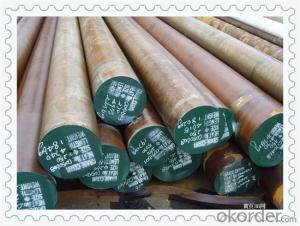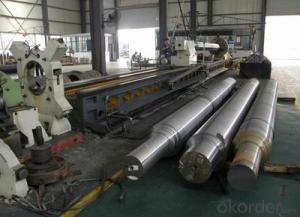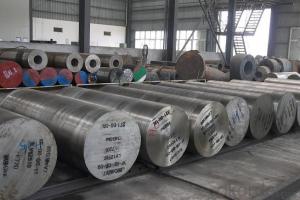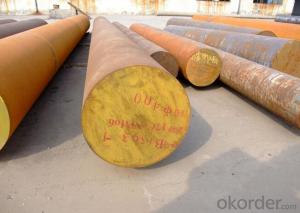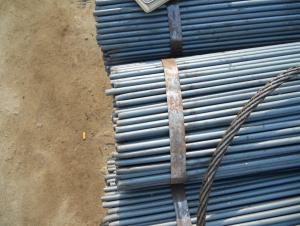40CrMo China Standard Forged Steel Round Bar
- Loading Port:
- Shanghai
- Payment Terms:
- TT or LC
- Min Order Qty:
- 25 m.t.
- Supply Capability:
- 10000 m.t./month
OKorder Service Pledge
OKorder Financial Service
You Might Also Like
Product Description:
OKorder is offering Round Bar at great prices with worldwide shipping. Our supplier is a world-class manufacturer of steel, with our products utilized the world over. OKorder annually supplies products to European, North American and Asian markets. We provide quotations within 24 hours of receiving an inquiry and guarantee competitive prices.
Product Applications:
1) Suitable for making various strong cutting tool abrasion resistance, impact resistance.
2) Used to produce all kinds of high hard and super hard saw blade, drill, tap, broach, gear hob and various kinds of milling cutter.
3) Used for advanced punching die, screw die, and the toughness and complicated shape of the punch, etc.
Product Advantages:
OKorder's Round Bar are durable, strong, and resist corrosion.
Main Product Features:
· Premium quality
· Prompt delivery & seaworthy packing (30 days after receiving deposit)
· Corrosion resistance
· Can be recycled and reused
· Mill test certification
· Professional Service
· Competitive pricing
Product Specifications:
Diameter | Mass | Diameter | Mass | Diameter | Mass |
(mm) | (kg/m) | (mm) | (kg/m) | (mm) | (kg/m) |
6 | 0.22 | 22 | 2.98 | 53 | 17.30 |
7 | 0.30 | 24 | 3.55 | 56 | 19.30 |
8 | 0.40 | 25 | 3.85 | 60 | 22.20 |
9 | 0.50 | 26 | 4.17 | 63 | 24.50 |
10 | 0.62 | 28 | 4.83 | 65 | 26.00 |
11 | 0.75 | 30 | 5.55 | 70 | 30.20 |
12 | 0.89 | 32 | 6.31 | 75 | 34.70 |
13 | 1.04 | 34 | 7.13 | 80 | 39.50 |
14 | 1.21 | 36 | 7.99 | 85 | 44.50 |
15 | 1.39 | 38 | 8.90 | 90 | 49.90 |
16 | 1.58 | 40 | 9.86 | 95 | 55.60 |
17 | 1.78 | 42 | 10.90 | 100 | 61.70 |
18 | 2.00 | 45 | 12.50 | 120 | 88.85 |
19 | 2.23 | 48 | 14.20 | 140 | 120.93 |
20 | 2.47 | 50 | 15.40 | 150 | 138.82 |
Packaging & Delivery of High Quality Round Bar
Packaging Detail: All goods are packed in bundle with steel strips and shipped by break bulk vessel or container (depend on target market and different ports)
Delivery Detail: 45 days
Trade terms: FOB, CFR, CIF
MOQ: 25 tons per specification; we can negotiate the quantity if the specification is normal or we have stock of one specification.
Weight: Theprice invoicing on theoretical weight basis or actual weight basis depends on customer’s request.
Shipment: The shipment of bulk break or container is depends on customer’s request and the situation of the port of destination.
Documents given: Full set of original clean on board bill of lading; Original signed commercial invoice; Original packing list; Policy of insurance; Certificate of origin and what the target market needs.
FAQ:
Q1: Why buy Materials & Equipment from OKorder.com?
A1: All products offered byOKorder.com are carefully selected from China's most reliable manufacturing enterprises. Through its ISO certifications, OKorder.com adheres to the highest standards and a commitment to supply chain safety and customer satisfaction.
Q2: How do we guarantee the quality of our products?
A2: We have established an advanced quality management system which conducts strict quality tests at every step, from raw materials to the final product. At the same time, we provide extensive follow-up service assurances as required.
Q3: What makes stainless steel stainless?
A3: Stainless steel must contain at least 10.5 % chromium. It is this element that reacts with the oxygen in the air to form a complex chrome-oxide surface layer that is invisible but strong enough to prevent further oxygen from "staining" (rusting) the surface. Higher levels of chromium and the addition of other alloying elements such as nickel and molybdenum enhance this surface layer and improve the corrosion resistance of the stainless material.
Images:
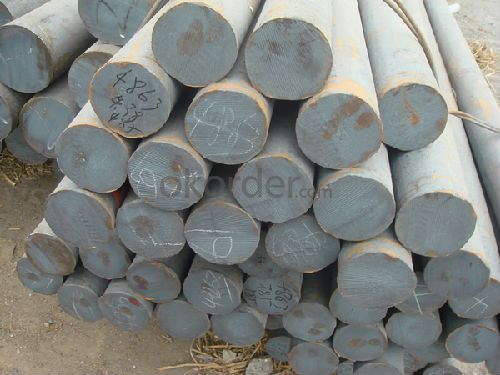
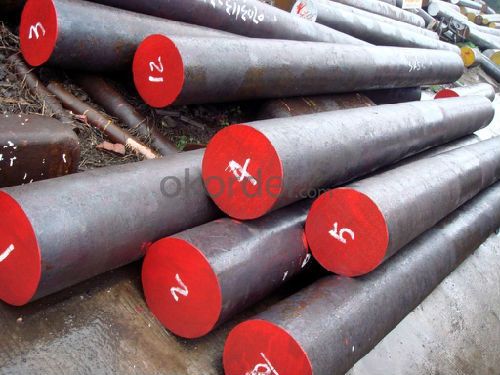
- Q: What is the thermal conductivity of a steel round bar?
- The thermal conductivity of a steel round bar can vary depending on the specific type of steel and its composition. Generally, carbon steel has a thermal conductivity ranging from 26 to 48 watts per meter-kelvin (W/m·K), while stainless steel typically has a slightly lower thermal conductivity of 15 to 27 W/m·K. However, these values are approximate and can vary based on factors such as temperature, impurities, and alloying elements. It is important to note that thermal conductivity is a property that describes the material's ability to conduct heat and is usually measured in units of W/m·K.
- Q: How do you identify the grade of a steel round bar?
- The grade of a steel round bar can be identified through several methods. One way is to check the markings or labels on the bar itself. Manufacturers often stamp or engrave the grade directly onto the surface of the bar. These markings typically include information such as the grade designation (e.g., 304, 316, 4140), which represents the specific alloy composition, and may also include additional details such as the heat or lot number. Another method is to refer to the mill test certificate (MTC) that accompanies the steel round bar. The MTC provides comprehensive information about the composition, mechanical properties, and other relevant specifications of the material. The MTC is usually issued by the steel mill or supplier and can be requested upon purchase. Moreover, visual inspection and physical testing can help identify the grade of a steel round bar. Visual inspection involves observing the bar's appearance, texture, and color. Different grades of steel may exhibit distinct characteristics, such as a shiny or matte finish, specific surface treatments, or variations in color due to different alloying elements. Physical testing methods, such as tensile or hardness testing, can provide further confirmation of the steel grade. These tests measure the mechanical properties of the material, such as its strength, ductility, and hardness. By comparing the test results with known standards and specifications for different steel grades, one can determine the grade of the round bar. In summary, to identify the grade of a steel round bar, one can check for markings on the bar, refer to the mill test certificate, visually inspect the bar, and perform physical tests to assess its mechanical properties.
- Q: Can steel round bars be coated with protective coatings?
- Indeed, it is possible to apply protective coatings to steel round bars. These coatings function as a shield, safeguarding the steel against corrosion, abrasion, and other forms of harm. The most prevalent form of protective coating for steel round bars is known as a corrosion-resistant coating. It is typically administered using methods such as hot-dip galvanization, electroplating, or powder coating. These coatings establish a protective layer that prevents the steel from encountering corrosive substances, moisture, and other environmental elements that may lead to deterioration. Furthermore, these coatings have the potential to enhance the aesthetic appeal of the steel round bars and extend their lifespan.
- Q: What are the advantages of using shock-resistant steel round bars?
- The advantages of using shock-resistant steel round bars are that they have high strength and toughness, making them suitable for applications where there is a high risk of impact, vibrations, or sudden loadings. These bars can withstand heavy loads and absorb energy, reducing the risk of structural failure or damage. Additionally, shock-resistant steel round bars offer improved resistance to wear, corrosion, and fatigue, resulting in longer service life and reduced maintenance costs.
- Q: What are the advantages of using nickel-tin alloy steel round bars?
- There are several advantages of using nickel-tin alloy steel round bars. Firstly, the addition of nickel improves the corrosion resistance of the steel, making it suitable for applications in harsh and corrosive environments. Secondly, tin improves the machinability and workability of the steel, allowing for easy shaping and fabrication. Additionally, the alloy steel round bars exhibit high strength and excellent mechanical properties, making them ideal for structural applications that require durability and reliability. Lastly, the combination of nickel and tin enhances the overall performance and longevity of the steel, making it a cost-effective choice in various industries such as automotive, aerospace, and marine.
- Q: Can steel round bars be used for hydraulic applications?
- Indeed, hydraulic applications do permit the use of steel round bars. Renowned for its robustness and endurance, steel proves a fitting substance for hydraulic systems demanding intense pressure and substantial burdens. Steel round bars facilitate the production of diverse hydraulic constituents, including cylinders, pistons, shafts, and valves. Moreover, steel's sturdiness and resistance to corrosion render it an unwavering option for hydraulic applications wherein the fluid may harbor impurities or undergo elevated temperatures. Nonetheless, it remains crucial to ponder over the specific prerequisites of the hydraulic application and meticulously choose the grade and type of steel round bars to ensure supreme performance and longevity.
- Q: Can steel round bars be used for shafts or axles?
- Yes, steel round bars can be used for shafts or axles. Steel round bars are commonly used for these applications due to their high strength, durability, and ability to withstand heavy loads and torsional forces. They can be machined and shaped to fit specific requirements, making them suitable for various industrial and mechanical applications.
- Q: How are steel round bars used in the construction of stadiums and sports facilities?
- Due to their strength, durability, and versatility, steel round bars find wide application in the construction of stadiums and sports facilities. Typically made from carbon steel, these bars come in various diameters and lengths to cater to the specific requirements of each project. An important function of steel round bars in stadium construction is reinforcing concrete structures. They are commonly embedded within concrete columns, beams, and slabs to enhance their load-bearing capacity and overall structural integrity. The exceptional tensile strength of steel enables it to withstand heavy loads and provide crucial support for large seating areas, roofs, and other architectural elements. Moreover, steel round bars are utilized in the construction of stadium roofs and canopies. These structures demand a material that is both strong and lightweight, capable of spanning long distances without excessive reliance on support columns. Steel bars, when designed and installed properly, offer an optimal solution by providing the necessary strength while minimizing the number of support elements, thus allowing unobstructed views and spacious seating arrangements. In addition, steel round bars are commonly employed in the fabrication of stadium fences, guardrails, and handrails. These components are essential in ensuring the safety and security of spectators, preventing falls or accidents in elevated areas, and guiding the flow of people within the facility. The high tensile strength of steel makes it an ideal material for these applications, providing the necessary resistance against impact. To summarize, steel round bars play a crucial role in the construction of stadiums and sports facilities. Their strength, durability, and versatility make them the preferred choice for reinforcing concrete structures, constructing roofs and canopies, and fabricating safety components. By incorporating steel round bars, stadiums can be built to withstand heavy loads, offer unobstructed views, and ensure the safety of spectators, ultimately enhancing the overall experience for sports enthusiasts.
- Q: Are steel round bars used in the manufacturing of machinery?
- Yes, steel round bars are commonly used in the manufacturing of machinery. Steel round bars are a versatile and durable material that can be used in various applications, including the construction of machinery components. The round shape allows for easy machining and fabrication, making it suitable for producing shafts, axles, gears, and other critical parts in machinery. The high strength and toughness of steel make it ideal for withstanding heavy loads and impact, ensuring the reliability and longevity of the machinery. Additionally, steel round bars can be customized and tailored to meet specific design requirements, allowing manufacturers to create machinery that is efficient, precise, and capable of delivering optimal performance.
- Q: Why is the round bar bent?
- Round steel with hooks the aim is to increase the bond between concrete and prevent the component in the tension will be reinforced. Therefore, round bars should be 180 degrees of hook, should set up 90 degree hook ribbed bar.
Send your message to us
40CrMo China Standard Forged Steel Round Bar
- Loading Port:
- Shanghai
- Payment Terms:
- TT or LC
- Min Order Qty:
- 25 m.t.
- Supply Capability:
- 10000 m.t./month
OKorder Service Pledge
OKorder Financial Service
Similar products
Hot products
Hot Searches
Related keywords
